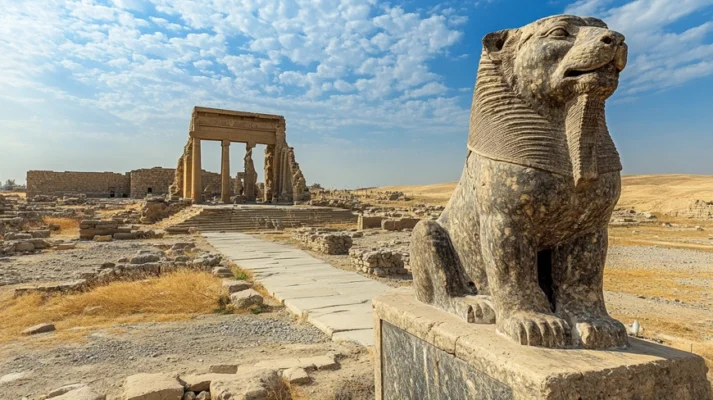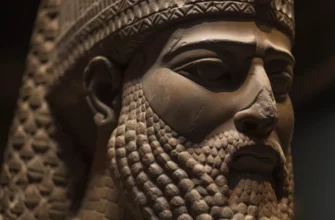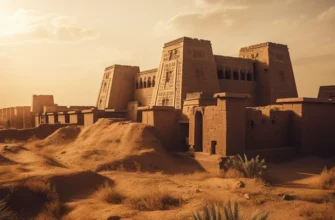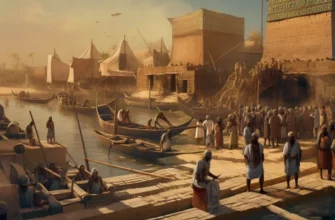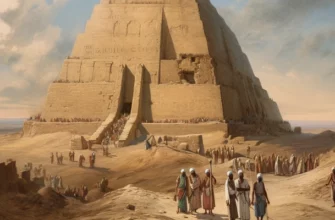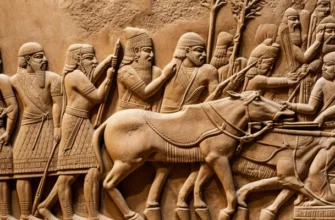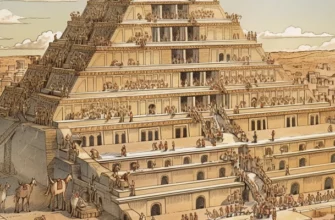Eridu is considered the oldest city of the Sumerian civilization and one of the first centers of urbanization in human history. It was located in southern Mesopotamia, in the area of modern Iraq, not far from the Persian Gulf.
Founded around 5400 BC, Eridu is mentioned in Sumerian myths as the first city created by the gods. Its patron was Enki, the god of water, wisdom, and magic. The city had a large temple dedicated to Enki, around which a settlement later grew.
Eridu was of great religious significance. The Sumerians believed that civilization began here. The ziggurat built in Eridu is one of the oldest architectural symbols of Sumerian culture.
Over time, Eridu lost its influence due to climate change and the expansion of neighboring cities. Around 2000 BC, the city was finally abandoned, leaving behind an archaeological legacy.
Today, the ruins of Eridu are an important research site that sheds light on the early stages of human civilization.
- The significance of Eridu for Sumerian civilization
- Place in world history
- Archaeological value and discoveries
- Geographical location and founding of the city
- Legends about the creation of the city
- Architecture and structure of the city
- Ziggurats of Eridu – religious buildings
- Religion and culture of Eridu
- Worship of Enki: the main temple of the city
- The myth of the flood and its connection to Eridu
- Eridu’s legacy for the modern world
- Conclusion
The significance of Eridu for Sumerian civilization
Eridu holds a special place in the history of Sumerian civilization, as it is considered one of the first cities in the world. It was not only the beginning of urbanization, but also served as an important religious, cultural, and economic center. Eridu was home to the temple of the god Enki (also known as Ea in Akkadian mythology), the deity of water, wisdom, and creativity.
The city became a place of worship and religious cult, which played a key role in the formation of Sumerian cosmology. The Sumerians believed that Eridu was the first city created by the gods, from which life on earth began.
Eridu served as a model for other Sumerian city-states, such as Ur and Uruk. Its mythology, architecture (especially ziggurats), and socio-economic structure laid the foundation for Sumerian culture. Early traditions emerged here, which later spread to other regions of Mesopotamia.
Eridu symbolizes humanity’s transition from a nomadic lifestyle to settled agriculture. In Sumerian myths, it was depicted as the first city to receive “mes” – divine grace, which includes the art of governance, crafts, and knowledge.
The ruins of Eridu demonstrate the early achievements of the Sumerians in construction, urban planning, and religious practices. The discovery of this city helps to study the origins of civilization and its evolution.
Eridu is not only a historical and cultural phenomenon, but also a symbol of human ingenuity, creativity, and the desire for an organized social life.
Its legacy remains valuable for understanding the early stages of human development.
Place in world history
Eridu occupies a unique place in world history as one of the oldest cities of mankind. Its significance extends far beyond the Sumerian civilization, as it became a symbol of the beginning of urbanization, religious development, and social organization.
Eridu is considered the first city built in the Fertile Crescent, a region where the first centers of agriculture, crafts, and trade emerged. Its founding around 5400 BC reflects humanity’s transition from a nomadic to a sedentary lifestyle.
Religion played a central role in the formation of social order, and the temple complex of Eridu became a model for subsequent religious buildings. The Sumerian tradition considered Eridu to be the first city created by the gods, which influenced the religious beliefs of neighboring cultures.
The ruins of Eridu preserve evidence of early technological achievements, such as the construction of ziggurats and the use of irrigation for the development of agriculture. These inventions became the basis for the subsequent civilizations of Mesopotamia, Egypt, and the Indus Valley.
Eridu is not only an archaeological site but also a symbol of human ingenuity.
It inspires researchers to uncover the mysteries of the past, forming an idea of the first stages of the development of societies.
In world history, Eridu occupies an honorable place as the cradle of civilization, which established traditions that left their mark on the culture, architecture, and governance of subsequent eras.
Archaeological value and discoveries
Eridu is a unique archaeological site that allows researchers to study the origins of urbanization and the development of human civilization. Its discovery was an important step in understanding the early history of Mesopotamia and the Sumerians.
Archaeological excavations
Excavations in Eridu began in the 20th century when archaeologists found the remains of an ancient city. The main sites were:
The Ziggurat of Eridu – one of the oldest religious buildings, built in honor of the god Enki.
The temple complex – the remains of religious buildings that testify to the cult practices of the Sumerians.
Pottery and tools – the artifacts found indicate a high level of craftsmanship and trade.
Layers of the settlement
Research has shown that the city had numerous cultural layers reflecting periods of settlement and renewal. The oldest of these date back to around 5400 BC, making Eridu one of the oldest urban settlements in the world.
The discovery of Eridu helped confirm the historical records of the Sumerians, particularly their royal lists, which mention the city as the first in history. The finds also shed light on how ancient civilizations developed irrigation systems, architecture, and social structures.
Eridu demonstrates humanity’s first steps toward creating organized societies with their own culture, religion, and economy. Its archaeological value lies in the opportunity it provides to study the origins and development of these processes.
Eridu remains one of the most important archaeological sites, helping us understand how the first cities influenced the evolution of humanity.
Geographical location and founding of the city
Eridu was located in the south of ancient Mesopotamia, within the borders of modern Iraq. The city was located near the coast of the Persian Gulf, in a region that the Sumerians called “the land between two rivers” — the Tigris and Euphrates. At the time of Eridu’s founding, this area was part of the resource-rich Fertile Crescent, which provided favorable conditions for agriculture and early urbanization.
Its location near water resources was of great importance. A system of irrigation canals allowed the Sumerians to grow crops, creating the basis for economic prosperity. Fertile, silt-rich soils promoted the development of agriculture, while access to water ensured fishing.
Eridu was founded around 5400 BC, making it one of the oldest cities in the world. According to Sumerian mythology, the city was created by the gods, and its main patron was Enki, the god of water, wisdom, and magic. Eridu was believed to be the first city to receive the divine gift of “mes” — the knowledge necessary to create culture and civilization.
According to Sumerian legends, Eridu was the first settlement after the creation of the world, where the gods began to organize human life.
It is mentioned in the Sumerian royal lists as the place where one of the first kings ruled.
Eridu also has symbolic significance, as it was located on the border between land and water, embodying the Sumerian idea of order and chaos. This emphasizes its religious status and importance for the formation of the region’s culture.
Its geographical location and favorable natural conditions made Eridu an ideal place for the emergence of one of the first urban centers of humanity, which left a deep mark on the cultural heritage of the world.
Legends about the creation of the city
According to Sumerian mythology, Eridu was created by the god Enki (the Akkadian equivalent of Ea), who was considered the god of water, wisdom, magic, and creation. His name is inextricably linked to the founding of this city, which was considered the first center of civilization given to humans by the gods.
The Sumerians believed that Eridu arose on the border between fresh waters (which personified order) and the salty sea (a symbol of chaos). It was from this place that the god Enki began his creative activity, establishing order and ensuring the prosperity of mankind.
The myth of Enki and “mes”
Legends say that after creating the world, Enki settled in Eridu and built his palace there—the underground temple “Abzu,” which symbolized the abyss of fresh water.
Enki endowed the city with the divine blessing of “mes” — the knowledge, arts, and laws necessary for the existence of civilization. It is believed that it was because of these gifts that Eridu became the first city where organized culture emerged.
Enki as the patron of Eridu
In the temple of Eridu, the Sumerians performed rituals that glorified Enki as the source of wisdom and harmony. He was not only the creator of the city, but also the protector of its inhabitants, who believed that the god provided them with abundant water, fertile soil, and protection from evil forces.
The myth of the flood and the salvation of mankind
In Sumerian legends, Enki plays a key role in the myth of the Great Flood. When the other gods decided to destroy mankind because of its sins, Enki, who remained the protector of humans, warned the hero Ziusudra (the prototype of the biblical Noah) of the danger. This myth is associated with Eridu, because it was there that Enki gave humanity the knowledge necessary for survival.
The city was considered not only the home of Enki, but also the point where the forces of heaven and earth meet. Legends about its creation convey the Sumerians’ ideas about the divine origin of culture and the inseparable connection between humans and the gods.
These legends emphasize the importance of Eridu as the mythical “cradle of civilization” and spiritual center where humanity received its first knowledge and laws from a divine patron.
Architecture and structure of the city
Eridu is considered one of the earliest examples of organized urban planning. Its architecture and structure reflect the early stages of Sumerian civilization, combining religious, administrative, and domestic functions.
The temple complex of Eridu
The central element of the city was a temple dedicated to the god Enki, located on a ziggurat, a massive stepped structure that served as both a religious center and a symbol of divine presence.
The ziggurat of Eridu is one of the oldest examples of this architectural form, which became characteristic of Sumerian cities.
Temple buildings were constructed from clay and fired bricks, which was typical for Mesopotamia due to the lack of stone.
The temples were decorated with bas-reliefs, statues, and ornaments depicting divine scenes and mythological creatures.
Residential areas
Residential neighborhoods consisting of simple houses were located around the temple:
Materials: houses were built from sun-dried clay, as this was the most readily available material.
Layout: houses had inner courtyards that were used for cooking and household chores.
Irrigation system: residential areas were surrounded by canals that provided water for agriculture and domestic use.
Public buildings
In addition to temples, Eridu had places for gatherings and trade.
Public squares: served as centers for markets and festivals.
Warehouses: used to store grain and other products, emphasizing the organized nature of the city’s economy.
Irrigation system
The Sumerians introduced irrigation technologies that were advanced for their time. Eridu was surrounded by a network of canals and reservoirs that ensured soil fertility by irrigating the fields and protecting the city from flooding.
Eridu was more than just a city—it was a symbolic space that embodied the religious beliefs of the Sumerians. The tall ziggurats sought to connect the heavens and the earth, and the careful planning of the city attests to a developed social organization.
The architecture of Eridu became the basis for the building traditions of the Sumerian civilization, which influenced the development of cities throughout Mesopotamia and beyond.
Ziggurats of Eridu – religious buildings
The ziggurats of Eridu are religious buildings that were characteristic of ancient Sumer. Eridu is considered one of the first major cities of Mesopotamia, and it was here, according to archaeologists and historians, that the first ziggurats appeared. The ziggurat in Eridu was dedicated to the god Enki, who was an important figure in Sumerian religion.
A ziggurat is a multi-story pyramid-shaped tower that served as a temple for the gods. They were built of fired bricks and had numerous staircases leading to the top, where rituals and sacrifices were performed. Ziggurats varied in height, and their shape symbolized the connection between heaven and earth, emphasizing the importance of religious rituals.
Eridul, located in the southwestern part of modern Iraq, was an important religious and cultural center, and the ziggurat in this city was considered one of the first examples of this architectural form, which became popular in other cities of Mesopotamia, such as Ur and Nippur.
Religion and culture of Eridu
Eridu, one of the oldest cities of ancient Sumer, was an important religious and cultural center. Located in the southwestern part of modern Iraq, the city played a significant role in the development of religion, culture, and social life in Mesopotamia.
Religion in Eridu
The god Enki: Eridu was dedicated to the god Enki (also known as Ea in Akkadian mythology). Enki was the deity of water, wisdom, magic, and creation. He was considered one of the most important gods in the Sumerian pantheon and had a sanctuary in Eridu, which became a religious center for worship. His temple in the city was an important place of religious pilgrimage.
Cult of water and water sources: Since Enki was the god of water, the cult in Eridu was closely associated with water sources, rivers, and other water resources.
The city was located near a river, which contributed to the development of this theme in religious beliefs and rituals. Ziggurat as a cult building: One of the first ziggurats was built in Eridu, which served as a temple for the worship of the god Enki.
A ziggurat is a pyramid-shaped multi-tiered structure that symbolized the connection between heaven and earth. The Sumerians believed that the gods lived at the top of the ziggurats, and therefore structures of this type were of great religious significance.
Rituals and sacrifices: Religious life in Eridu was closely linked to various rituals, sacrifices, and festivals in honor of the gods. The Sumerians made animal sacrifices, offerings, and fire rituals, and also used symbolic rituals to maintain the connection between humans and gods.
Culture in Eridu
Architecture and urban planning: Eridu was one of the first cities to develop in Mesopotamia, and its architecture had a significant influence on the culture of the time. The city had a well-organized infrastructure, including temples, palaces, and residential quarters. Great emphasis was placed on building with fired clay, which allowed for the construction of structures that were strong and resistant to climatic conditions.
Arts and crafts: The Sumerians in Eridu were engaged in various crafts, such as weaving, pottery, jewelry, and metalworking.
Preserved artifacts testify to the high skill in the production of ceramics, jewelry, and statuettes, which had both domestic and religious significance. Writing: An important part of the Eridu culture was Sumerian writing. Although the Sumerians initially used pictographs, a system of cuneiform writing developed over time.
This writing system was used to record trade agreements, religious texts, and literary works. One of the first forms of writing was clay tablets, on which texts were inscribed in cuneiform.
External relations and trade: Like many other cities in Sumer, Eridu actively traded with neighboring cultures. Trade helped the economy grow and also encouraged cultural exchange with other peoples in Mesopotamia, Persia, India, and even Egypt.
Mythology and literature: The Sumerians in Eridu developed their own mythology, which included numerous deities, heroic epics, and religious tales. One of the important myths was about the creation of the world and religious stories that mainly focused on the interaction between gods and humans. This also helped form the basis for later literary traditions in Mesopotamia, such as the Epic of Gilgamesh.
Religion and culture in Eridu were closely intertwined, particularly through the worship of the god Enki and the development of cult buildings such as ziggurats. The city became an important religious and cultural center that had a huge influence on the development of civilization in the Mesopotamian region and on the further history of Sumer.
Worship of Enki: the main temple of the city
The worship of the god Enki in Eridu was an extremely important aspect of the religious life of the city, and his main temple was one of the central architectural and religious structures. Enki, the god of water, wisdom, magic, and creation, was one of the most important deities in the Sumerian pantheon, and his cult had a great influence on the life of the community of Eridu and Sumer in general.
The main temple of Enki in Eridu
Location and architecture: The main temple of Enki in Eridu was one of the first major religious centers, demonstrating the importance of religion in Sumerian society.
The temple was part of a large religious complex that also included a ziggurat, a multi-tiered pyramid-like structure symbolizing the connection between heaven and earth. The ziggurat, located within the temple grounds, was where priests and priestesses performed religious rituals and sacrifices in honor of Enki.
Role of the ziggurat: The ziggurat at the Temple of Enki was one of the main architectural features characteristic of Sumerian religious buildings. It consisted of several tiers that gradually decreased in size, and at its top was a sanctuary where the most important religious rituals, including sacrifices, prayers, and worship of the god, probably took place. Ziggurats served as “bridges” between heaven and earth, symbolizing the presence of the gods at their peaks.
Temple complex: The Temple of Enki in Eridu was surrounded by other cult and religious buildings where rituals were performed, religious texts were composed, and sacred artifacts were kept. The temple itself was a place where religious ministers (priests and priestesses) performed rituals that included sacrifices, prayers, purification rites, and other religious practices. Religious and cultural texts were also kept there, including records of myths, rituals, and cult practices.
Religious rituals and worship: The worship of Enki in Eridu included numerous rituals that reflected his functions as the god of water and wisdom. An important part of religious practices were sacrifices, including sacred animals, as well as gifts such as bread, beer, and various foods that had symbolic meaning. Believers believed that through these rituals they maintained the favor of the god who brought fertility and prosperity.
Role in society: The temple of Enki in Eridu was important not only from a religious but also from a political point of view. Temples in Sumer were not only religious centers but also important economic and social institutions. They had their own land holdings, which were cultivated by slaves or hired workers, and it was in such places that numerous economic and administrative operations were carried out. Temple complexes were also important for cultural and educational activities, in particular for the preservation and transmission of knowledge through writing and religious texts.
The temple of Enki in Eridu was an important religious center that determined the religious life not only of this city but of all Sumer.
The ziggurat and temple in Eridu symbolized the unity between humans and gods, and the cult of Enki as the god of water and wisdom had a profound meaning for Sumerian culture and religion. Architecture: The temple was a huge structure built of fired bricks.
The temple was usually located on a high elevation, as ziggurats — pyramid-shaped cult buildings — symbolized the connection between heaven and earth. Its top, as in other ziggurats, was a place where rituals and sacrifices were performed in honor of the god.
Religious rituals: Important religious rituals and sacrifices were performed in the temple, particularly in honor of Enki. Gifts were offered and sacred water rituals were performed, symbolizing purification and connection with the god. Water, as the main attribute of Enki, was a key element in these rituals.
Sacred status: E-abzu was not only a temple but also the cultural and religious center of Eridu. This place was not only used for worship but also became a center of learning and wisdom, where knowledge about magic, medicine, and water, which were closely associated with Enki, was passed down.
Enki’s role: Enki was an important deity for the Sumerians because he possessed knowledge that helped people solve problems and achieve harmony with the forces of nature. His cult in Eridu symbolized not only the worship of water, but also devotion to wisdom and creativity.
The worship of Enki in the E-abzu temple included various rituals, such as singing, praying, and ritual dances. Water rituals were an important element, as Enki was the god of water. People brought sacrifices to the temple, both living and symbolic, to please the deities.
The traditions of worshiping Enki in Eridu had a great influence on the religious practices of other cities in Sumer, as the cult of this god was widespread throughout Mesopotamia, although its main center remained in Eridu.
The myth of the flood and its connection to Eridu
The flood myth is one of the oldest and best known in Sumerian mythology, and it has a direct connection to Eridu, the ancient city that was the center of worship of the god Enki. According to Sumerian mythology, the gods decided to destroy humanity because of its sins and the chaos in the world. However, one of the gods, Enki, who was the god of water, wisdom, and magic, warned a hero named Utnapishtim (in the Akkadian version, his name is Ziusudra) about the coming flood. He sent him a warning that he must build a large ship to save himself from the disaster. Utnapishtim had to save a pair of every species of living creature on this ship.
The flood lasted several days and nights, destroying all life on earth. After the waters receded, Utnapishtim set out with his ship in search of land, and when he finally found land, he made sacrifices to the gods. The gods, impressed by his loyalty and devotion, decided to grant him immortality. Utnapishtim became a divine figure who preserved the knowledge of the catastrophe and the restoration of humanity.
Eridul is an important place in this context because it was in this city that the cult of the god Enki was centered, who played a decisive role in preventing the flood and preserving life. The temple of Enki in Eridu was a place of worship and religious rituals, and it was this god, through his wisdom and divine power, who helped humanity survive the catastrophe. The myth of the flood in Eridu, in particular, emphasizes the importance of wisdom and divine intervention in human life and demonstrates the close connection between religion, the city, and water deities such as Enki.
This myth has parallels with other ancient myths, notably the biblical myth of Noah. Both myths tell of a catastrophic flood, after which humans must rebuild life on Earth, but the Sumerian version is one of the oldest, also demonstrating the profound significance of religious beliefs associated with water, divine justice, and the restoration of the world.
Eridu’s legacy for the modern world
Eridu’s legacy to the modern world is significant, as it is one of the oldest cities of civilization and became an important center for the development of religion, culture, art, and science. Eridu was a city that became the cradle of numerous ideas and concepts that influenced the further development of humanity, and its importance cannot be underestimated.
One of the most important legacies of Eridu is the religious beliefs and cultures that formed the foundations of Sumerian religion and cults. Eridu was an important religious center where the god Enki, the god of water and wisdom, was worshipped. The city became a center for the creation of cult buildings such as ziggurats, multi-tiered pyramid-shaped structures that symbolized the connection between heaven and earth. Ideas related to divine intervention and the importance of temples in public life had a profound influence on religious traditions in many cultures. In particular, ziggurats became the basis for the development of cult buildings in later cultures, such as Babylon.
The development of writing is another important part of Eridu’s legacy. It was in Sumer, particularly in Eridu, that the first forms of writing, including cuneiform, were created. This type of writing was used to record important economic, religious, and literary texts. Cuneiform became the basis for most of the writing systems of Mesopotamia and also influenced later writing systems, such as Phoenician and later Greek. Writing in Sumer and Eridu was an important tool for preserving knowledge and passing it on to future generations.
Ideas about justice and governance were also a significant part of Eridu’s legacy. The city became an important economic and political center where trade, administrative functions, and the storage of cultural knowledge took place. The economy was based on religious and administrative structures that were later adapted by other cultures. Many legal and administrative concepts, such as taxes, resource management, and urban planning, have their roots in the experience gained in the cities of Sumer, particularly in Eridu.
The architectural heritage of Eridu, particularly the ziggurats and temple complexes, continues to influence architectural traditions to this day. Ziggurats, which symbolized the relationship between the divine and the earthly, became the basis for later religious structures such as the pyramids in Egypt and the Mesoamerican pyramids.
Finally, the mythology of Eridu, especially the flood myth, which has survived in various forms in many cultures, has had a major influence on the development of literature, religion, and philosophy. This myth inspired many cultures to create their own versions of stories about catastrophic events and the rebirth of humanity. Ideas about divine intervention in human affairs, justice, and recovery after disaster have been preserved in various myths and religions around the world.
Thus, the legacy of Eridu not only left a deep mark on the development of architecture, religion, literature, and science, but also influenced global cultural traditions. The city became an important center for the formation of ideas and values that later became the foundation for many great civilizations.
Conclusion
Eridul, one of the oldest cities of Sumer, is a symbol of the beginning of civilization, as it became an important center for the development of culture, religion, architecture, and writing, which determined the further development of human societies.
This city, in particular, became a center of worship for Enki, the god of wisdom and water, and was one of the first places where cult buildings such as ziggurats were created, symbolizing the connection between humans and gods.
Eridu’s role in the development of writing, in particular the creation of cuneiform, was unprecedented. It became the basis for recording not only economic and religious texts, but also myths and literary works that preserved knowledge for future generations. This aspect of Eridu helped lay the foundation for the development of intellectual culture and the transmission of knowledge, which became an important factor in the further progress of civilizations.
Eridul is also important as a model for the organization of urban life, where concepts of justice, governance, and spatial planning developed. Its influence on later cultural traditions is undeniable, and many of the ideas that emerged in Eridul were reflected in other great civilizations.
Thus, Eridulu is a symbol of the beginning of civilization not only because of its achievements in religion, art, and science, but also because of the role it played in shaping the basic principles of human life that became the foundation for the development of subsequent great civilizations. This city is a testament to how one of the first settlements on Earth could become the cradle of enormous changes that determined the future of humanity.
